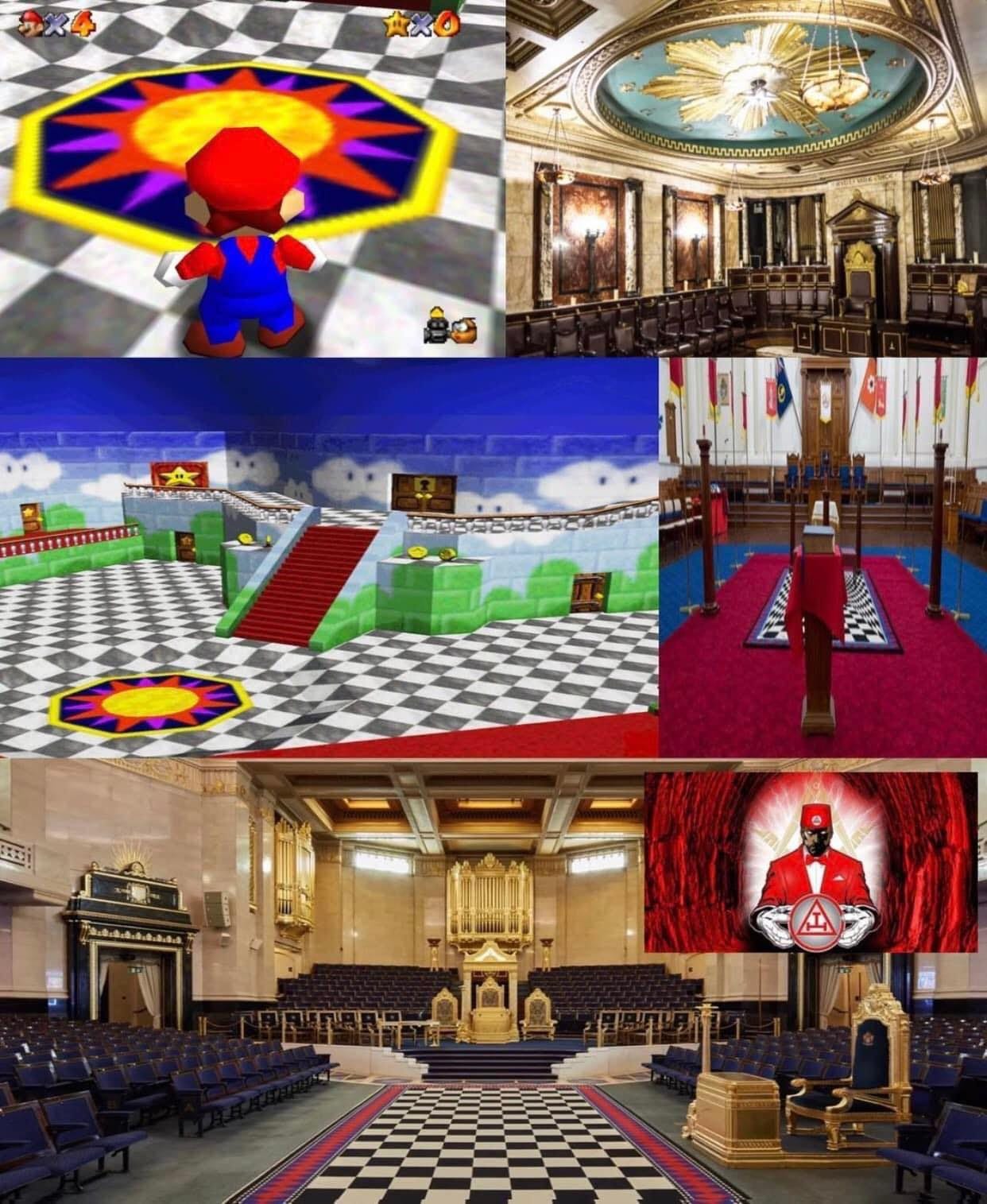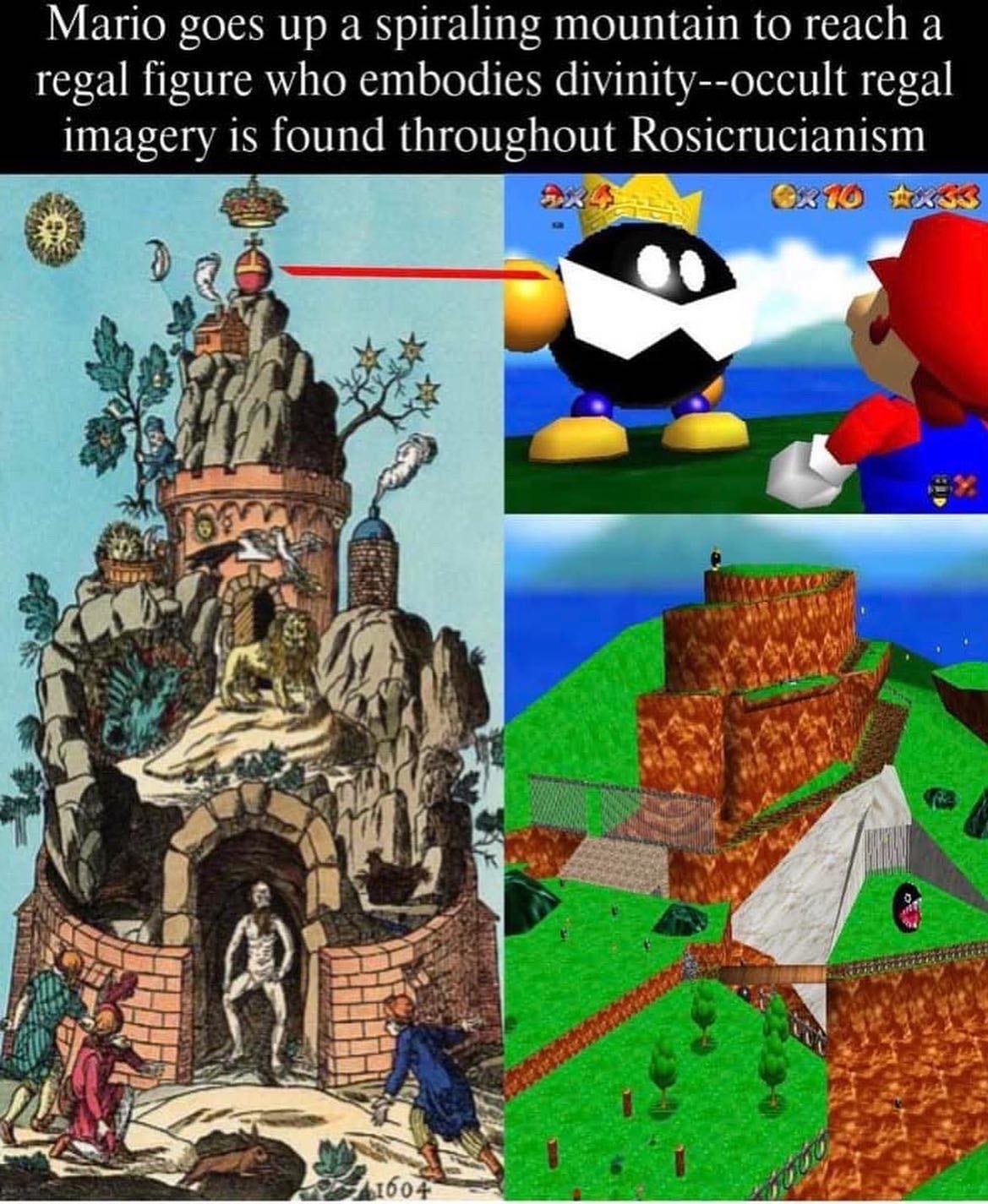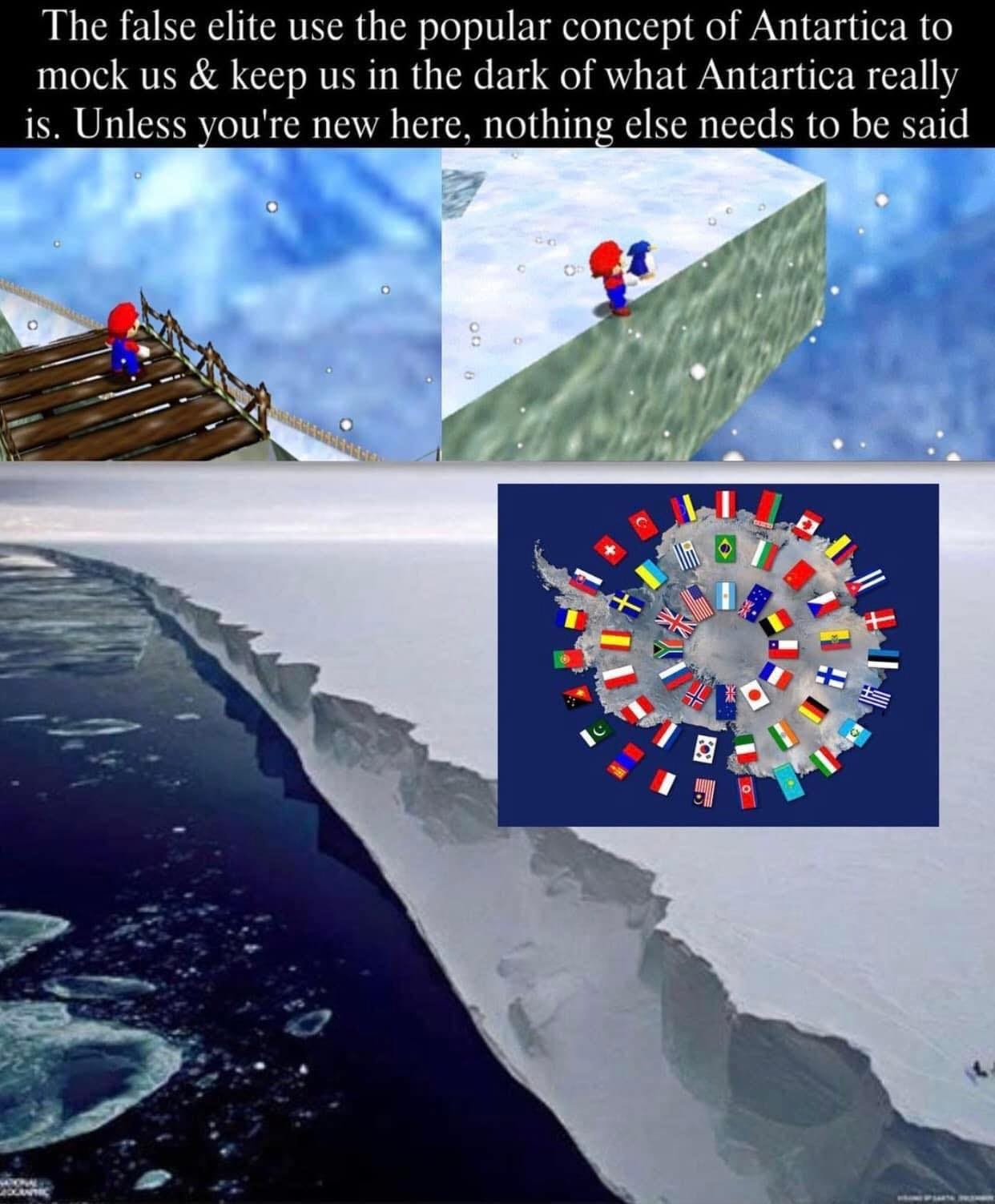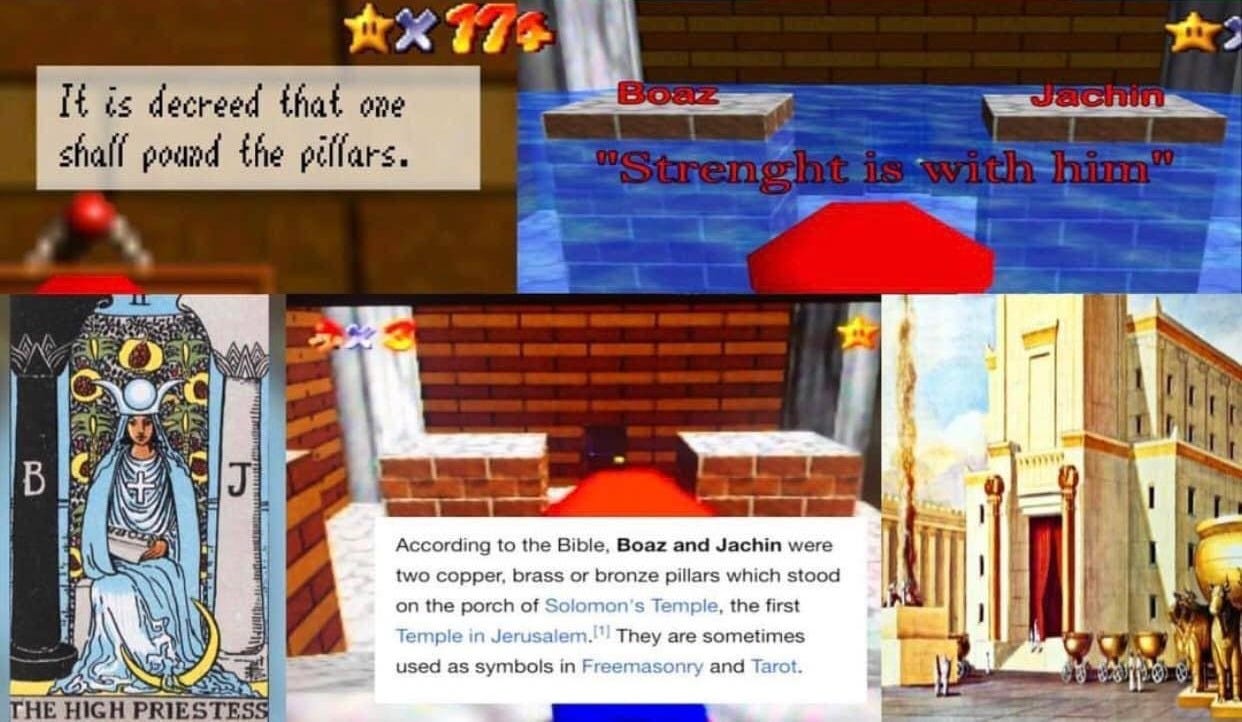Unmasking Mario: The Esoteric Secrets of Super Mario 64
Decoding the Hidden Symbolism in a Gaming Icon
Published 20:00 28th June 2025
By A Gaming Scribe
The Mario Connection
Since its groundbreaking release in 1996, Super Mario 64 has enchanted millions with its vibrant, three-dimensional landscapes and the endearing antics of its mustachioed plumber hero. Crafted by Nintendo, a Japanese gaming titan that transformed from a humble card maker into a global entertainment powerhouse, this title redefined interactive storytelling and cemented Mario’s legacy as a cultural colossus. Yet, beneath the cheerful jumps and coin-collecting quests lies a labyrinth of symbols—checkerboard floors, spiraling mountains, and cryptic rituals—that hint at profound, perhaps unsettling meanings. Are these mere artistic flourishes, or do they conceal an esoteric agenda orchestrated by hidden forces? This article unveils two lenses: a rational perspective rooted in historical and creative context, and a conspiracy view that probes the shadowy depths of occult lore, loosh harvesting, and the Anunnaki-Jesuit-Masonic trinity.
Disclaimer: Two Sides to Every Coin presents two perspectives on historical and cultural events: a rational, historian-journalist view grounded in documented facts, and a conspiracy view exploring esoteric theories (loosh, trinity: Anunnaki-Jesuit-Masonic). The conspiracy perspective is speculative, intended for entertainment and thought-provoking discussion, and does not reflect verified historical truth. Readers are encouraged to research and form their own conclusions.
The Masonic Hall: A Gateway to Initiation
Rational Perspective
The journey into Super Mario 64 begins within a majestic hall, its floor adorned with a striking checkerboard pattern, a radiant solar disk at its center, and a luxurious red carpet stretching into the distance. These elements resonate with architectural motifs found in historic European structures, particularly Masonic lodges, where the checkerboard symbolizes balance and duality—a design choice possibly inspired by Nintendo’s exposure to Western aesthetics during its global rise. The solar disk, a nod to celestial harmony, and the hall’s three-tiered layout might reflect influences from Renaissance art or Japanese temple architecture, which Shigeru Miyamoto, Mario’s visionary creator, has cited as inspiration alongside his childhood explorations of Kyoto’s gardens. This suggests a deliberate aesthetic homage rather than a cryptic code, crafted to immerse players in a fantastical world.

Conspiracy Perspective
This hall is no mere backdrop—it’s a digital Masonic temple, a portal to initiation rites veiled within pixels. The checkerboard floor, a cornerstone of Freemasonry, represents the polarized dance of light and dark, the physical realm where rituals unfold. The solar disk, glowing with esoteric significance, hints at the hidden enlightenment sought by initiates, while the red carpet traces the Royal Arch’s path of sacrifice and prestige. The three-tiered structure mirrors the sacred progression of Masonry’s degrees—Entered Apprentice, Fellowcraft, Master Mason—casting Mario’s adventure as a covert initiation. The Anunnaki-Jesuit-Masonic trinity may have orchestrated this, embedding the game with symbols to subtly reprogram the collective psyche. Here, the first tendrils of loosh—energy born of awe and submission—begin to flow, harvested as players step into this grand illusion.
Mercury’s Journey: A Psychopomp in Pixels
Rational Perspective
Mario’s odyssey across Super Mario 64’s 15 expansive courses—diving into crystalline waters, plunging into subterranean caverns, and soaring toward celestial heights—showcases the game’s pioneering 3D technology. His nimble, Mercury-like movements reflect a design rooted in mythological inspiration, as Miyamoto has openly drawn from global folklore, including Greek myths, to shape characters like Link in The Legend of Zelda. The gleaming coins scattered throughout are clever gameplay incentives, encouraging exploration and rewarding skill, a testament to Nintendo’s focus on engaging, family-friendly entertainment rather than esoteric intent.

Conspiracy Perspective
Mario is no ordinary plumber—he’s a digital incarnation of Mercury, the pagan god and Kabbalistic force of Hod, a psychopomp guiding souls between realms. His ascent up a spiraling mountain to confront a regal figure—such as the crowned Big Boo—mirrors the Rosicrucian alchemical quest for divine union, a path steeped in Anunnaki lore of celestial descent and ascent. The coins, reimagined as pentacles, are occult talismans of material wealth, each collection a ritual offering that siphons loosh—emotional energy—into the trinity’s grasp. Jesuits may have refined this narrative to subvert spiritual awakening, while Masons encoded the Sephiroth’s mystical structure, using Mario’s leaps to imprint archetypes onto the collective unconscious, a silent reprogramming across millions of screens.
Pentacles, Owls, and Mock Baptisms
Rational Perspective
The game’s golden coins and occasional owl sightings add a layer of whimsy to its colorful universe. The coin’s pentacle-like shape is likely a serendipitous design choice, enhancing visual appeal, while the owl—appearing in levels like “Big Boo’s Haunt”—may nod to wisdom, a motif common in children’s literature and media. The water-dipping sequences, where Mario plunges into lakes or pipes to unlock new areas, are ingenious mechanics that deepen gameplay, reflecting Nintendo’s commitment to interactive fun rather than any ritualistic undertone.

Conspiracy Perspective
The coins are no mere collectibles—they are pentacles, drawn from Tarot’s realm of material mastery and Masonic wealth symbolism, each one a loosh-laden tribute to the trinity’s power. The owl, a sentinel of secret societies emblazoned on the dollar bill and tied to Athena’s wisdom, beckons players to peer into shadows, harvesting curiosity and unease. The mock baptisms—Mario’s repeated submersion in digital waters—parody sacred rites, a Jesuit ploy to erode spiritual purity, while Anunnaki feast on the resulting emotional turbulence. This saturation of rituals, far beyond gameplay needs, serves as Masonic predictive programming, conditioning millions to accept hidden influences with a laugh or a shrug.
Templar Echoes and Underwater Secrets
Rational Perspective
The underwater levels, with their shimmering depths and pirate-like undertones, evoke the adventurous spirit of maritime tales that Miyamoto might have encountered in global literature or cinema. The inclusion of Knights Templar imagery alongside these scenes appears to be a creative flourish, possibly sourced from public domain art to enrich the game’s visual tapestry, with no historical or corporate link to Nintendo’s development process.

Conspiracy Perspective
Beneath the waves lies a Templar enigma—after their 1312 dissolution, these knights allegedly vanished underwater, re-emerging as pirates to safeguard Anunnaki knowledge from a pre-flood world. Mario’s aquatic “baptisms” mock this submerged legacy, with the skull and crossbones—tied to Jacques de Molay’s execution—hinting at a Jesuit-Masonic cover-up. The trinity exploits this confusion, siphoning loosh from players’ awe and bewilderment, using Nintendo as a vessel to obscure this ancient secret beneath a playful facade.
Antarctica’s Hidden Mockery
Rational Perspective
The snowy expanses of levels like Cool, Cool Mountain offer a refreshing contrast to the game’s warmer realms, likely inspired by alpine landscapes Miyamoto admired during his travels. The Antarctica reference, paired with international flags, mirrors the continent’s real-world status as a collaborative research frontier, a factual design choice to broaden the game’s global appeal rather than a conspiratorial statement.

Conspiracy Perspective
These snowy levels are a taunting jest, mocking Antarctica’s true nature as a guarded enigma. The flat, icy edge hints at a hidden realm—perhaps an inner Earth portal or a pre-flood civilization—concealed by the “false elite” trinity. Anunnaki origins might lie beneath, with Jesuits crafting the popular icy wasteland narrative and Masons enforcing global treaties to restrict access. Mario’s climb along this edge harvests loosh from curiosity and denial, a ritualistic reminder of suppressed truths.
Boaz, Jachin, and the Pentacle’s Power
Rational Perspective
The pillars and pentacle motifs enrich the game’s mystical ambiance, possibly drawing from architectural history like Solomon’s Temple or Tarot iconography. These elements enhance the visual storytelling, a deliberate choice by Nintendo to captivate players with an otherworldly vibe, devoid of deeper intent beyond aesthetic allure.

Conspiracy Perspective
The pillars Boaz and Jachin, towering symbols from Solomon’s Temple, frame a Masonic ritual space where Mario’s pentacle collection feeds Anunnaki energy needs. The Pythagorean Pentacle, with its planetary lore, encodes a Jesuit-crafted narrative of divine balance, while Masons orchestrate the loosh harvest from players’ engagement. Each coin gathered, each pillar passed, amplifies the trinity’s influence, a silent symphony of emotional extraction.
Conclusion: A Digital Ritual Unveiled
Super Mario 64 stands as a testament to Nintendo’s genius—or a trinity’s tool. The rational view celebrates its artistry; the conspiracy lens uncovers a loosh-laden ritual. As you navigate its worlds, consider the symbols’ dual nature and forge your own path to understanding.
Copyright: © Steven & Chasing Tartaria 2025. All rights reserved. This article is part of the Two Sides to Every Coin series on Substack. Images and historical data are sourced from public domain archives (e.g., Manx National Heritage, British Newspaper Archive) or credited where applicable. Reproduction or distribution without permission is prohibited.




